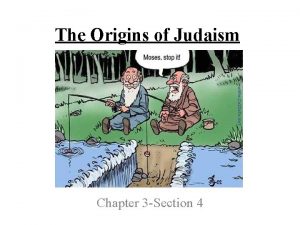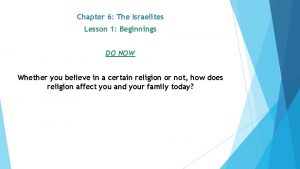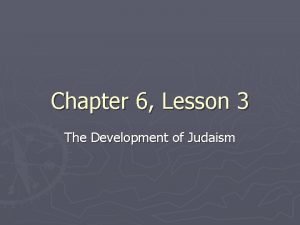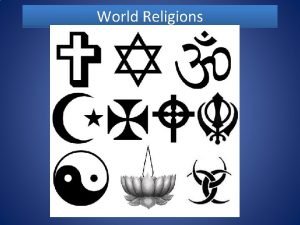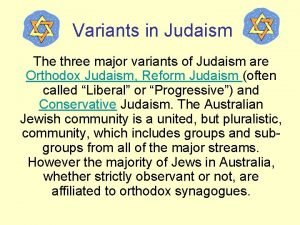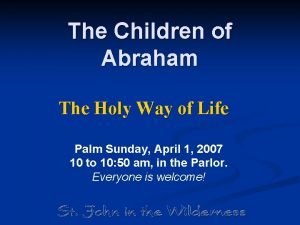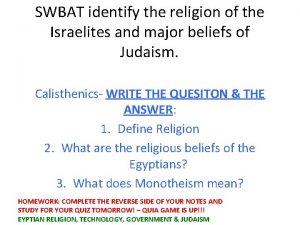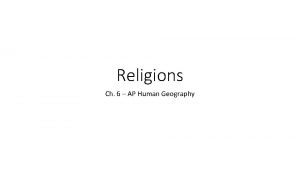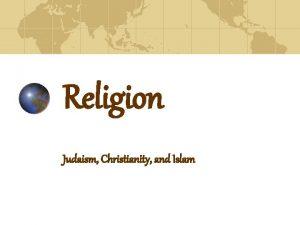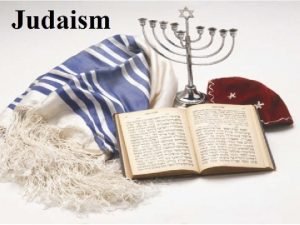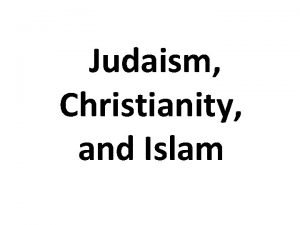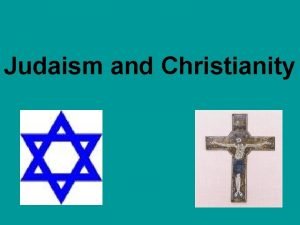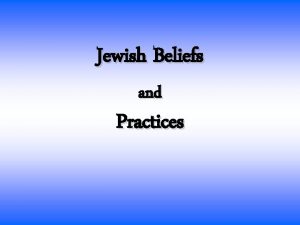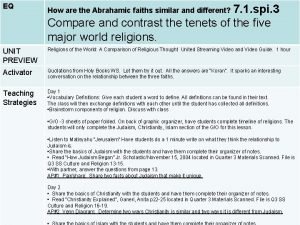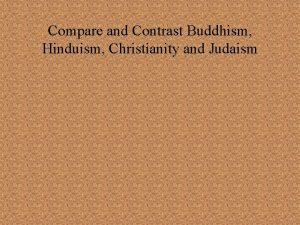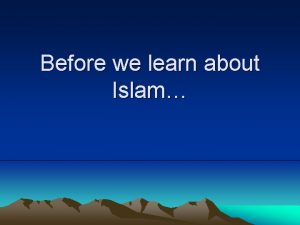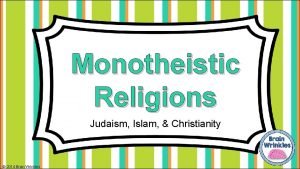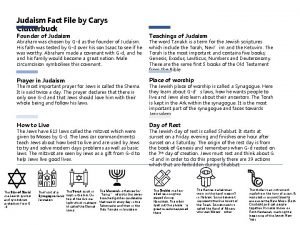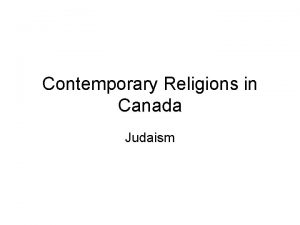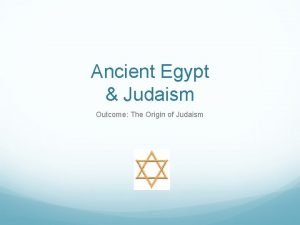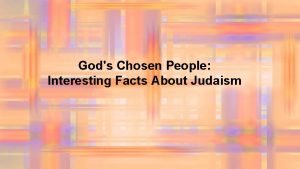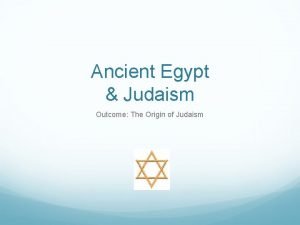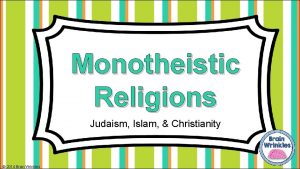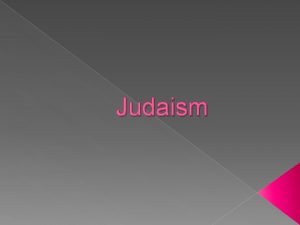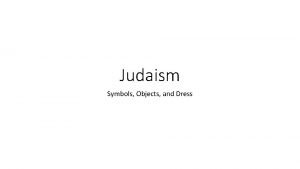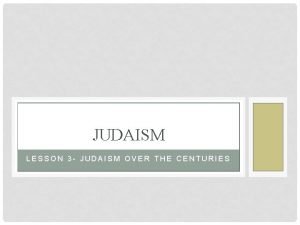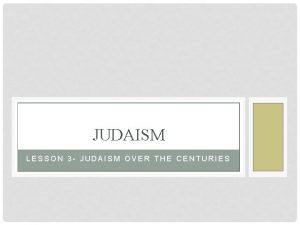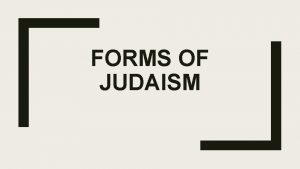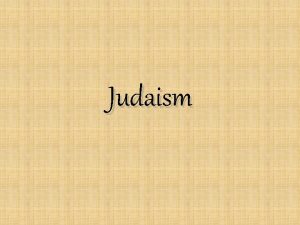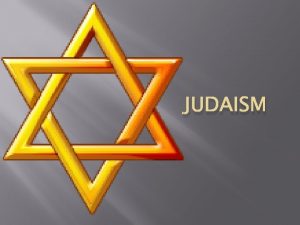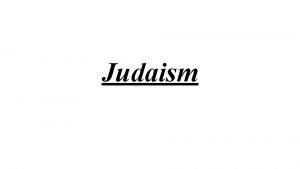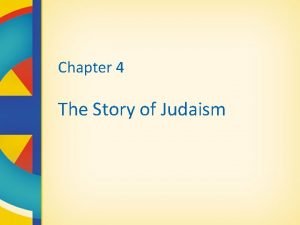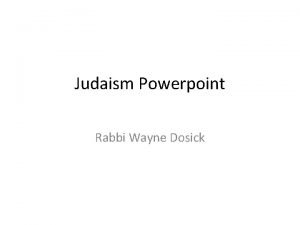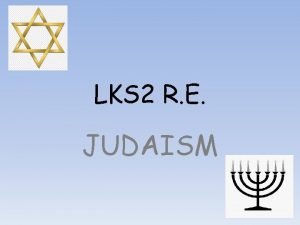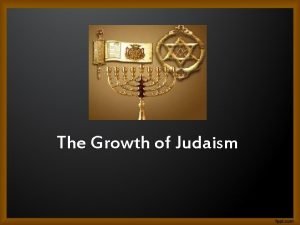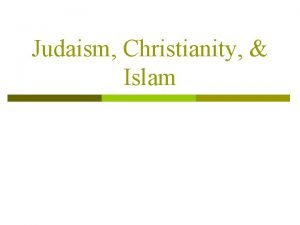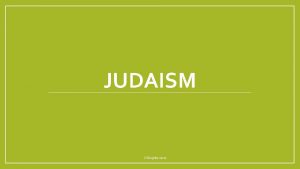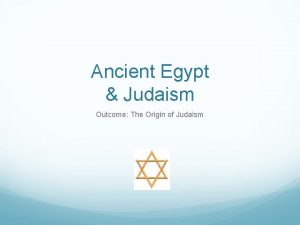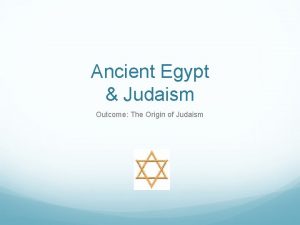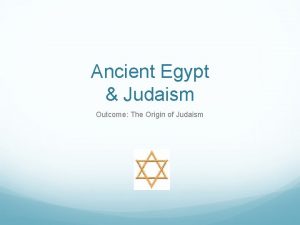CHAPTER 2 JUDAISM Part 1 Part 2 PPL2






























- Slides: 30

CHAPTER 2: JUDAISM Part 1 & Part 2 PPL#2 have been posted on Senior Religion Website

JUDAISM Chapter 2 (EROW) PPL#2 (Part 1)

A LIVING RELIGION ■ Expression of beliefs through personal and communal prayer ■ Study of the Torah ■ Study of the ancient Israelite People ■ What a Jew believes is reflected in how a Jew acts ■ The proclamation of one God ■ Israel is both a nation and a people

■ Judaism is the religion of the Jews BUT Not all Jews practice Judaism – Being a Jew has both an ethnic and religious connotation ■ Ethnic Jews – May or may not practice Judaism ■ Religious Jews – May also be an ethnic Jew – But could be from another ethnicity ■ Our focus in this chapter (and in this class) will be on Religious Jews

Make sure to get the information from page 29 into your notes! FYI – THESE ARE ALL THE SAME PEOPLE Hebrews Jews The Chosen People Israelites Reference to the same place: Promised Land = Canaan = Land Flowing with Milk & Honey

Section #1: A BRIEF HISTORY OF JUDAISM ■ History spans 1000’s of years ■ Jewish culture has contributed significantly to the world – esp. the Western World

BIBLICAL PERIOD ■ Beginning with Abraham ca. 1800 BCE – Circa (about) abbreviated ca. ■ Concludes with the death of Alexander the Great 323 BCE (A t G) ■ Out of Faith and Obedience – Abraham and his wife Sarah move from Ur in Mesopotamia to the land of Canaan (along the Fertile Crescent) ■ Habiru (Hebrews) – Nomadic tribes that would gradually settle into agricultural systems ■ Generations later Hebrews would move to Egypt in order to escape a serious drought ■ At first they were welcomed immigrants into Egypt but would eventually be enslaved by the powerful government of Egypt

ca. 1250 BCE ■ Moses frees the Israelites from Egypt – Hebrews had lived in Egypt for 400 years ■ 40 years through the desert to return to Canaan ■ Became a covenantal community (Covenant) with allegiance to God only ■ Moses dies before entering Canaan and Joshua lead the Hebrews into the Promised Land ■ They had to conquer the inhabitant of Canaan before they could resettle ca. 1050 BCE ■ Hebrew people became a confederation of tribes ■ Established a powerful kingdom ■ Kings Saul, David & Solomon ■ Jerusalem becomes the political and religious center of the Hebrew people ■ Under King Solomon a Temple in Jerusalem was built ■ For almost 1000 years things remained relatively stable for the Hebrew people

“As the people became more powerful, they saw less need for the God who once freed them. Prophets such as Samuel and Nathan became more prominent, exhorting the Hebrew people to follow the ways of the one God rather than the ways of the neighboring Canaanite gods. ” (Clemmons 31)

During the time that Jews are settled in Canaan The Temple of Solomon is built The oral history (stories passed from generation to generation) begins to be written down and compiled into what would become the Torah. The word “Torah” means Law/Instruction

Death of Solomon A Divided Kingdom ■ Kingdom to the north “Israel” with 10 Tribes ■ Kingdom to the south “Judah” with 2 Tribes ■ Becoming more vulnerable to outside threats (especially due to idolatry)

ca. 722 BCE ■ The Kingdom of Israel falls to the Assyrians ■ Northern Kingdom in exile 586 BCE ■ Babylonians conquer Judah ■ Destroying the Temple ■ Exiling Judeans to Babylon ■ Approximately 50 years later Persia conquered Babylonia and allowed the Judeans to return to their land ■ They would rebuild the Temple

Living in the Land of Judah Ø The Hebrew people became known as Jews Ø During this time the Torah is completed Ø Prophets becoming less numerous Ø Wisdom literature is emerging which would later become included in the Hebrew Scriptures

Rabbinic Period ■ aka Classical Judaism – Begins in 323 BCE (also the year that Alexander the Great dies) – Ends in 625 CE ■ The year Jerusalem fell to the Islamic Army from the Arabian Peninsula ■ Growing number of Jews not living in their homeland became known as the Diaspora ■ In the late 4 th century Alexander the Great ruled over much of the “known world” including Judea ■ Later the Greek ruler Antiochus IV prohibited the practice of Judaism in Judea and took over the Temple

■ The Maccabees lead a revolt against the Greeks in 168 BCE – Regaining possession of the Temple in 165 BCE ■ The conquests of A of G had lasting repercussions and greatly influenced the culture of the known world with Greek ways including language – For example Philo of Alexandria ■ Jewish philosopher who was comfortable blending Greek philosophy with Jewish theology ■ The Hebrew Bible was translated into Greek in the 3 rd century BCE – The Septuagint “ 70” – Tradition says that 70 translators worked independently and yet came up with the exact translation of the text from Hebrew into Greek ■ During this period three groups emerge: Sadducees, Pharisees and Essenes

Get a pen, piece of paper & write a complete heading!

The Sadducees Jews who defined themselves as biological descendants of Zadok, the last high priest before the Babylonian exile. Held a strict position in the interpretation of the Torah. Do not accept the doctrine of resurrection The Pharisees Held a looser interpretation of the Torah Using oral tradition and popular customs in their interpretation of the Law of Moses. Accepted the doctrine of resurrection The Essene This community was unknown until 1948. Monastic nature Scrupulosity for the Law (a pathological guilt over moral/religious issues)

63 BCE ■ Roman army conquers the region of Judea ■ Greek rule ends ■ In the year 70 CE the Roman army attacks Jerusalem and destroys the Temple ■ Jews had to reinterpret their religious practices w/o a Temple ■ Eventually the Sadducees and the Pharisees disappear and the Rabbis gain prominence ■ To this day Rabbis are the spiritual leaders of Judaism ■ Rabbinical schools are opened ■ Rabbis start the process of transforming Temple rituals for practice outside the Temple ■ The 2 most influential Rabbinical Schools during the time of Jesus were Shammai and Hillel ■ Over the next few centuries Torah commentaries are compiled, codified and written into two works called the Babylonian Talmud and the Jerusalem (Palestinian) Talmud ■ Along with the Torah, the Talmud inspires and guides Jews in their religious life.

■ A growing tension begins to emerge between Jews who believe that Jesus is Messiah and those who do not – Both groups used the same Hebrew Bible but with radically different interpretations of the text ■ 2 nd c Emperor Hadrian wanted to establish a city where Jerusalem was – Build a shrine to the god Jupiter on the site of the Temple Mount – In 130 CE Simon bar Kociba lead a revolt against the Romans – It was quickly put down by the Roman Army – The name was changed from Judea to Palestine – The shrine was built – Jews were banned from ever returning to Jerusalem

Jews of the Diaspora Influenced by Greek and Roman cultural and civilization “Like all empires, Rome reached its glory and moved into a long, slow decline politically, economically, and militarily. At the end of the third century, the Emperor Diocletian separated the Empire into eastern and western portions, appointing a leader for each. ” (Clemmons 36) At the end of the 4 th c Christianity would become the official religion of the RE Jews were less prominent and treated as inferior By the beginning of the 5 th c the RE in the West no longer existed

Medieval Period ■ 638 -1783 CE ■ Jews began to live in places they had never lived before: – Western, Central, and Eastern Europe – Asia – Arabian Peninsula – North Africa ■ Through the development of Jewish philosophy, there were attempts to harmonize reason with faith. ■ The most famous Jewish philosopher was Moses Maimonides. ■ He argued that there was no contradiction between the philosophy of Aristotle and the Jewish religion.

■ Jewish persecution during this period – 7 th c Islam is emerging out of the Arabian Peninsula ■ Under Muslim rule, Jews were a “protected people” as long as they paid the tax for that protection. ■ They were able to worship as they wished as long as their synagogues were not taller than mosques, and they could conduct their own courts. ■ Clearly treated as second-class citizens ■ Just four years after the death of Muhammad, Muslims invaded Jerusalem, taking it away from the Byzantines. ■ This was a mixed blessing for Jews. ■ The Muslims constructed a beautiful shrine called the Dome of the Rock on the spot where the Holy of Holies of the Second Temple once stood.

Jews of Babylon Flourished under Persian rule Built great schools and synagogues Muslims took on the daunting task of reintroducing ancient Greek writings to the medieval world. Jews helped translate the writings from Greek to Arabic for Muslims and from Arabic to Latin for Christians of the West. From Baghdad, Islamic culture and civilization flourished and Jews were very much a part of the expansion. A large class of Jewish merchants arose. Jews acted as mediators between Christian and Muslim traders.

Cordoba, Spain ■ Where Jews thrived the most during the Medieval Period ■ Sephardim (Jews of the Mediterranean Region) ■ In the twelfth century - the Muslim Berbers came to power in Spain and ousted Jews from the country. ■ 15 th c – Reconquesta – – all non-Christians were – required to convert to – Christianity or to leave – Spain. ■ Spanish Inquisition – INFAMOUS!

11 th c Crusade ■ Jewish communities destroyed ■ 1000’s of Jews murdered ■ Jews denied ownership of land ■ Some chose to convert to Christianity ■ Economics moving from the barter system to money ■ Many Jews became moneylenders

• At the end of the thirteenth century, pogroms— officially encouraged massacres and expulsions —started against Jews in England. • In Poland, King Boleslav invited Jews to come to his country. • There they would be employed in various areas of finance and administration. • Because of the protection of the monarchy, Jews were able to thrive in Poland until the tide turned in the seventeenth century.

• In the late seventeenth century arose Rabbi Israel ben Eliezer, nicknamed the Ba’al Shem Tov, or “Master of the Good Name. ” • The Ba’al Shem Tov emphasized the presence of God in all aspects of Jewish life. • Amid the darkness of life that befell so many Jews, particularly in Eastern Europe, the message of Rabbi Israel ben Eliezer brought God, joy, and life itself into Jewish communities in a new way. • His message spread into a new movement within Judaism called Hasidism, from the Hebrew meaning “pious. ”

Modern Period ■ 1783 to the present ■ 19 th c Russia – Particularly brutal for Jews – Czar Alexander III – the May Laws against Jews ■ Jews were the scapegoats for economic problems and corruption of the govt.

• In Germany and later in the United States, Reform Judaism emerged, advocating full integration into the culture where one lived. • In the United States, the rise of Conservative Judaism counteracted Reform Judaism, modifying Jewish tradition in a limited manner. • Orthodox Judaism was also a reactionary movement in response to Reform Judaism. • Orthodox Judaism is the most traditional wing of Judaism • insisting its members strictly follow the Torah. • In the 1930’s -- Reconstructionist Judaism emerged from Conservative Judaism, advocating Judaism as a culture, not only a religion. • Reconstructionist Jews do not believe in an all-powerful God nor do they accept the Torah as inspired by God

• End of the 19 th c Jewish Nationalism grows – Zionist Movement • In response to the Holocaust the United Nations returned Palestine to the Jews • The State of Israel in 1948 • The city of Jerusalem was divided between Israel and Jordan • 1967 Israel captured all of Jerusalem in a conflict known as the Six-Day War • Returning Palestine to the Jews has caused a lot of conflict in that part of the world
 Chapter 3 section 4 the origins of judaism
Chapter 3 section 4 the origins of judaism The israelites lesson 1 beginnings
The israelites lesson 1 beginnings Guided reading the israelites lesson 3 answer key
Guided reading the israelites lesson 3 answer key Where is hinduism located today
Where is hinduism located today Variants of judaism
Variants of judaism Orthopraxy judaism
Orthopraxy judaism Judaism major beliefs
Judaism major beliefs Ethnic religions ap human geography
Ethnic religions ap human geography Core beliefs of judaism
Core beliefs of judaism Main beliefs of judaism
Main beliefs of judaism Judaism location
Judaism location Judaism vs christianity
Judaism vs christianity Judaism branches
Judaism branches Zakzt
Zakzt Hinduism and judaism compare and contrast essay
Hinduism and judaism compare and contrast essay What is judaism
What is judaism Judaism christianity and islam all began in southwest asia
Judaism christianity and islam all began in southwest asia Sacred text of judaism
Sacred text of judaism Judaism founder
Judaism founder Christianity and confucianism venn diagram
Christianity and confucianism venn diagram Monotheism chart judaism christianity islam
Monotheism chart judaism christianity islam Swansea synagogue
Swansea synagogue Religions
Religions Judaism place of origin
Judaism place of origin 2 interesting facts about judaism
2 interesting facts about judaism Triple venn diagram of judaism christianity and islam
Triple venn diagram of judaism christianity and islam Origins of judaism
Origins of judaism Religions that believe in reincarnation
Religions that believe in reincarnation Similarities of islam and judaism
Similarities of islam and judaism Which is the oldest monotheistic religion
Which is the oldest monotheistic religion Jewish symbols
Jewish symbols
